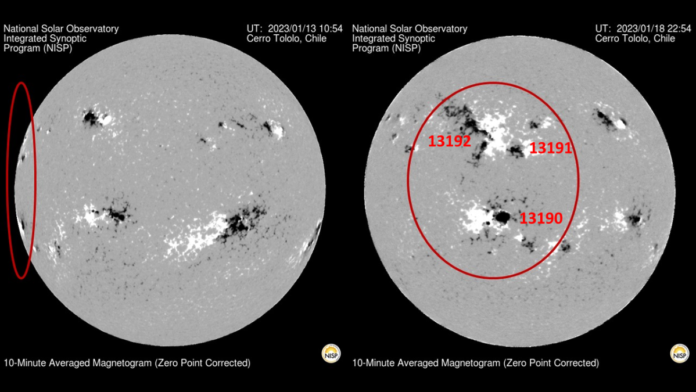Solar activity increased on Jan. 13 as massive active regions of the sun rounded its east limb to face Earth.
The location of the active regions, designated NOAA 13169 and NOAA 13170, had been predicted previously by the Global Oscillation Network Group (GONG), a network of telescopes across Earth that continuously monitor the sun. The newly visible active regions join other current active regions facing Earth, NOAA 13190, 13191 and 13192, which span the sun’s northern and southern hemispheres.
Observations from GONG, operated by the National Science Foundation (NSF), had also suggested that as these active regions turned to face Earth, our planet would witness an increase in explosive solar events including several M- class and C-class solar flares.
Related: Sun unleashes barrage of 8 powerful solar flares (video)
This prediction was also confirmed as the sun engaged in a violent display of solar flares, which fortunately have thus far posed no risk to Earth aside from minor radio blackouts associated with M-class flares.
“GONG’s farside imaging gave us about a two-week heads-up that two large active regions would soon appear on the Earth-side of the sun, increasing the potential for large flares and other solar activity that could negatively impact Earth,” Alexei Pevtsov, associate director of the National Solar Observatory’s Integrated Synoptic Program (NISP), which includes GONG, said in a statement. (opens in new tab) “It’s like getting an early warning of possible freezing temperatures in spring — the weather forecast may have some large uncertainties, but one could start preparing to take mitigating actions to save their flowering orchard from freezing.”
GONG relies on a technique called helioseismic holography, which uses soundwaves bouncing through the interior of the sun to develop a picture of solar activity on the side of our star facing away from us.
The huge active regions of the sun now facing Earth have previously produced coronal mass ejections (CMEs), but none directed toward Earth so far. CMEs are explosive outbursts of plasma and charged particles capable of carrying billions of tons of material from the sun at speeds of hundreds of miles (or kilometers) per hour.
CMEs can be harmful to astronauts and space technology, and if these strongly magnetic plasma bursts lash Earth’s protective magnetic bubble, the magnetosphere, they can create a disturbance that sends particle radiation into the upper layers of Earth’s atmosphere.
This disturbance can lead to surges in electrical currents that can overload power grids and communications infrastructure, causing widespread blackouts. For example, during the 1859 Carrington Event, a geomagnetic storm caused telegraph systems across the globe to fail.
The active regions of the sun will remain facing Earth until around Wednesday (Jan. 25), at which point they should move across the west limb of the sun and disappear from view.
Solar activity will continue to increase as the sun heads to the solar maximum phase of the current 11-year solar cycle, which has been labeled Solar Cycle 25; solar maximum should occur in 2025.
Follow us on Twitter @Spacedotcom or on Facebook.

